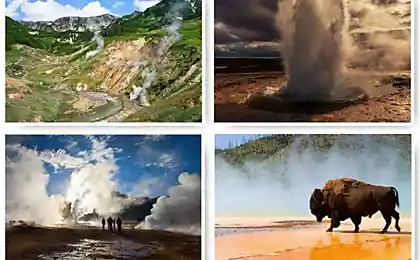2589
Geyser field world
November 1, 1934 in Kamchatka was formed Kronotsky State Nature Biosphere Reserve, which is one of the wonders of Russia - the Valley of Geysers. In honor of this event offer you a selection of well-known geyser fields in the world.

In the north-east of the island of Kyushu is the capital of the hot springs in Japan - the city of Beppu. Sacred sources of the same name being hosted in their territory about 2,800 keys, fumaroles and mikrogeyzerov. Particular attention of visitors attracted to the so-called "nine circles of hell" - nine unusual sources, each of which has a certain zest. For example, the source of "Shaved head» (Oniishibozu Jigoku) resembles a large boiling gray puddle.

The unusual name appeared due to bubbles resembling the shaven heads of Buddhist monks. But perhaps the most well-known source is considered Bloody Pond (Chinoike Jigoku). The unusual name appeared due to the red color of the pond, "colored" iron-containing minerals
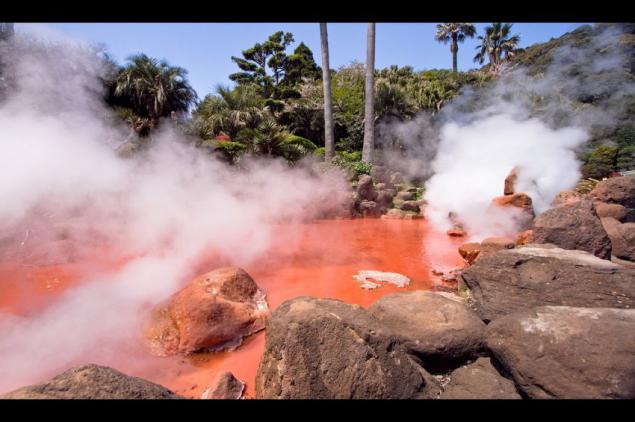
On Earth, there are five major geothermal areas with active geysers - four of them are in Iceland, New Zealand, United States and Kamchatka. The fifth valley of geysers hidden far and high. On the border with Bolivia, Chile, at an altitude of 4320 meters above sea level in the Andes is the most high geyser field in the world - El Tatio (App. El Tatio).

About 80 geysers release from the depths of the earth boiling water, reaching a height of 75 cm to 6.7 m. The best time to visit the valley is considered the dawn. At the time when the temperature reaches below zero marks, each of the sources of steam surrounds particular halo.

In addition, sources begin to gush before dawn and stop their activity at nine o'clock in the morning.

The word "geyser" is derived from the Icelandic «geysa», which means "gush". The first of documented and known to the world geysers Geysir (Geysir) was opened in 1294. He gave the name of all boiling and fluidized sources around the world. Like most of the geysers of Iceland, Geysir is located in the southeastern part of the island, in the valley of Haukadalur (Haukadalur), which literally means "garden hot springs." Unfortunately, the legendary Geysir has lost its activity as a result of the earthquake in 2000. But he was replaced Strokkur (Strokkur). He erupts every 5-10 minutes, throwing a jet of hot water to a height of 20 meters. Due to its restlessness he is considered one of the most active geysers in the world. Strokkur geyser eruption:
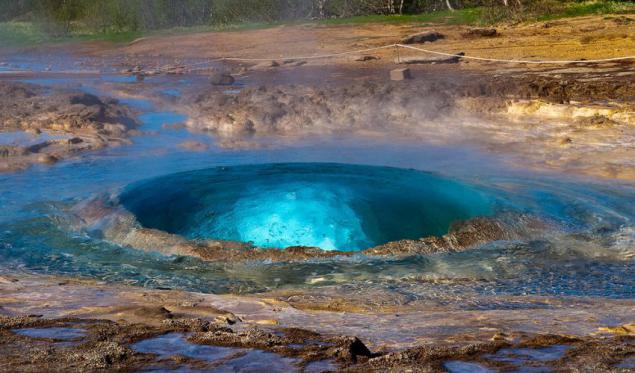
Like any geyser Strokkur work consists of several stages: filling the basin with water, man, ejection of hot jets of water and resting stage:


In this picture, you can look in detail at all phases of the eruption

The biggest and most powerful geyser in the world was in New Zealand - the height to which he raised the boiling water, sometimes reaching 400-450 meters. Waimangu Volcanic Rift Valley was active only 4 years since 1900. In the photo from the book «Picturesque New Zealand» 1913 shown his impressive eruption:

It is noteworthy that the Icelandic geysers valley until recently was owned by the director Sigurdur Jonasson, who passed it as a gift to the state. He bought this place in 1935. Previous owner James Craig, a manufacturer of whiskey, and later Prime Minister of Northern Ireland, shielded sources fence and charge people with entrance fee. Today everyone can see the Icelandic geysers for free. By the way, just in the country, there are about 30 active geysers.
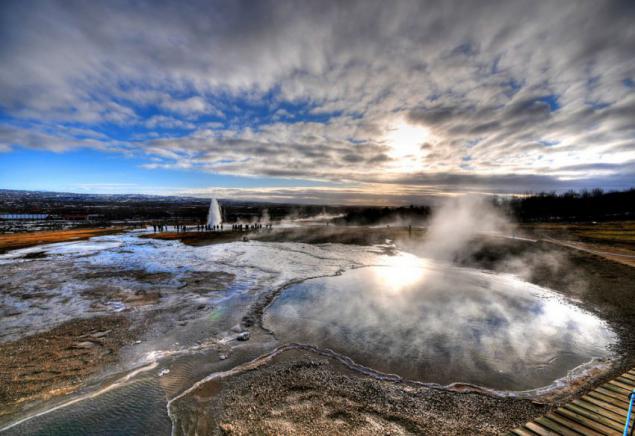
On the other side of the Pacific is a geyser that erupts above all other active geysers in the world. This source is located in Yellowstone National Park (USA) and is named Steamer (Eng. Steamboat). He throws out a jet of water at 91 meters up, which is practically equal to the height of the Statue of Liberty (93 m from the ground to the tip of the flame). His power is so great that the old pine trees growing nearby, were broken and washed away during one of the eruptions. By the way, it lasts 3 to 40 minutes. This geyser is unpredictable: it can wake up every four days, and can sleep up to 50 years, as it was in 1911. After a long lull, Steamboat woke up in 1961 - two years after one of the strongest earthquakes (magnitude 7, 5) that occurred in the Lake Hebgen. This year, July 31, the first geyser in the last eight years has been active.
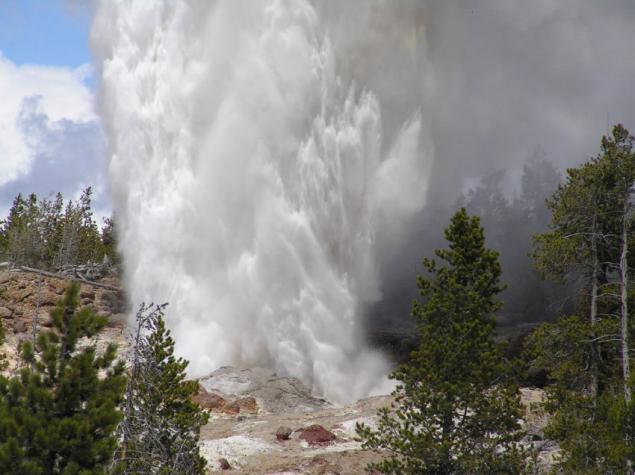
Another popular geyser park, which is called the Old Faithful (eng. Old Faithful), erupts more often and is famous for its punctuality. Almost every 90 minutes he throws a jet of hot water to a height of over 40 meters:

No less popular among visitors Grand Prismatic Spring (eng. Grand Prismatic Spring) - a boiling pot, which measures 91 meters long and 75 meters wide. He is known for his acid colors vary depending on the time of year due to living in a pond pigmented bacteria.

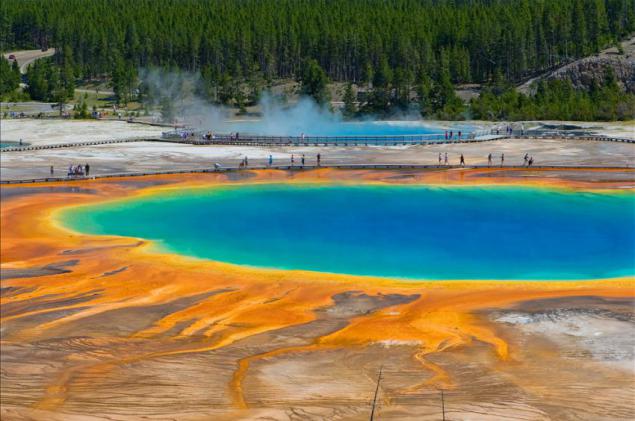
Incidentally, in Yellowstone National Park is a record number of geysers. On the area of 8983 square kilometers pulsate around 3 thousand hot springs, which represents two thirds of all the geysers of the world.

Valley of Geysers opened 7 years after the founding of the Kronotsky Nature Reserve. It happened in the summer of 1941 during an expedition Tatyana Ustinova and Anisifor Krupenina. Inaccessibility of the Valley of Geysers failed to detect a unique place before.

However, even today, not everyone can see the Kamchatka geysers. First, get to them it is possible unless the helicopter, and secondly, visiting only with the permission of the administration. The Valley of Geysers is a gorge up to 4 km and 8 km long, along the bottom of which flows the river Geyser. Over 6 km from the mouth of the river canyon slopes "stuck" around 40 geysers, hot springs, mud pots and volcanoes. (Photo Dimarik):

The pride of the valley is considered giant geyser. He erupts not often - it is a cycle of 5-7 hours. But when he wakes up, the jet of boiling water under pressure rises to 20-30 meters up, and clouds of steam can reach 300 meters! (Photo by Alexander Belousov):

Five years ago, 14 km from the Valley of Geysers geyser scored the young Russian. He became an unexpected discovery for employees Kronotsky Nature Reserve, where 28 September 2008 a jet of boiling water rose up from the ground in the middle of one of Kamchatka's most active hydrothermal systems of Kamchatka in the valley Uzon. It is believed that before this place beat source "Pulsing". To name the newly formed "fountain" allowed tourists who at the time were near. If employees do not reserve time thought again, geyser got was the name of "Cool". In the end, called it "cloudy". Initially, it erupted every 15-20 minutes in a year - about every 12 minutes in 2010 - an hour and forty minutes. Today jet of steam rises to 5-6 meters every 2-3 hours, but it depends on the weather cycle. Geyser responds to strong winds and the temperature difference, which is reflected in its activity. (Photo Dimarik):

Source: uainfo.org

In the north-east of the island of Kyushu is the capital of the hot springs in Japan - the city of Beppu. Sacred sources of the same name being hosted in their territory about 2,800 keys, fumaroles and mikrogeyzerov. Particular attention of visitors attracted to the so-called "nine circles of hell" - nine unusual sources, each of which has a certain zest. For example, the source of "Shaved head» (Oniishibozu Jigoku) resembles a large boiling gray puddle.

The unusual name appeared due to bubbles resembling the shaven heads of Buddhist monks. But perhaps the most well-known source is considered Bloody Pond (Chinoike Jigoku). The unusual name appeared due to the red color of the pond, "colored" iron-containing minerals

On Earth, there are five major geothermal areas with active geysers - four of them are in Iceland, New Zealand, United States and Kamchatka. The fifth valley of geysers hidden far and high. On the border with Bolivia, Chile, at an altitude of 4320 meters above sea level in the Andes is the most high geyser field in the world - El Tatio (App. El Tatio).

About 80 geysers release from the depths of the earth boiling water, reaching a height of 75 cm to 6.7 m. The best time to visit the valley is considered the dawn. At the time when the temperature reaches below zero marks, each of the sources of steam surrounds particular halo.

In addition, sources begin to gush before dawn and stop their activity at nine o'clock in the morning.

The word "geyser" is derived from the Icelandic «geysa», which means "gush". The first of documented and known to the world geysers Geysir (Geysir) was opened in 1294. He gave the name of all boiling and fluidized sources around the world. Like most of the geysers of Iceland, Geysir is located in the southeastern part of the island, in the valley of Haukadalur (Haukadalur), which literally means "garden hot springs." Unfortunately, the legendary Geysir has lost its activity as a result of the earthquake in 2000. But he was replaced Strokkur (Strokkur). He erupts every 5-10 minutes, throwing a jet of hot water to a height of 20 meters. Due to its restlessness he is considered one of the most active geysers in the world. Strokkur geyser eruption:

Like any geyser Strokkur work consists of several stages: filling the basin with water, man, ejection of hot jets of water and resting stage:


In this picture, you can look in detail at all phases of the eruption

The biggest and most powerful geyser in the world was in New Zealand - the height to which he raised the boiling water, sometimes reaching 400-450 meters. Waimangu Volcanic Rift Valley was active only 4 years since 1900. In the photo from the book «Picturesque New Zealand» 1913 shown his impressive eruption:

It is noteworthy that the Icelandic geysers valley until recently was owned by the director Sigurdur Jonasson, who passed it as a gift to the state. He bought this place in 1935. Previous owner James Craig, a manufacturer of whiskey, and later Prime Minister of Northern Ireland, shielded sources fence and charge people with entrance fee. Today everyone can see the Icelandic geysers for free. By the way, just in the country, there are about 30 active geysers.

On the other side of the Pacific is a geyser that erupts above all other active geysers in the world. This source is located in Yellowstone National Park (USA) and is named Steamer (Eng. Steamboat). He throws out a jet of water at 91 meters up, which is practically equal to the height of the Statue of Liberty (93 m from the ground to the tip of the flame). His power is so great that the old pine trees growing nearby, were broken and washed away during one of the eruptions. By the way, it lasts 3 to 40 minutes. This geyser is unpredictable: it can wake up every four days, and can sleep up to 50 years, as it was in 1911. After a long lull, Steamboat woke up in 1961 - two years after one of the strongest earthquakes (magnitude 7, 5) that occurred in the Lake Hebgen. This year, July 31, the first geyser in the last eight years has been active.

Another popular geyser park, which is called the Old Faithful (eng. Old Faithful), erupts more often and is famous for its punctuality. Almost every 90 minutes he throws a jet of hot water to a height of over 40 meters:

No less popular among visitors Grand Prismatic Spring (eng. Grand Prismatic Spring) - a boiling pot, which measures 91 meters long and 75 meters wide. He is known for his acid colors vary depending on the time of year due to living in a pond pigmented bacteria.


Incidentally, in Yellowstone National Park is a record number of geysers. On the area of 8983 square kilometers pulsate around 3 thousand hot springs, which represents two thirds of all the geysers of the world.

Valley of Geysers opened 7 years after the founding of the Kronotsky Nature Reserve. It happened in the summer of 1941 during an expedition Tatyana Ustinova and Anisifor Krupenina. Inaccessibility of the Valley of Geysers failed to detect a unique place before.

However, even today, not everyone can see the Kamchatka geysers. First, get to them it is possible unless the helicopter, and secondly, visiting only with the permission of the administration. The Valley of Geysers is a gorge up to 4 km and 8 km long, along the bottom of which flows the river Geyser. Over 6 km from the mouth of the river canyon slopes "stuck" around 40 geysers, hot springs, mud pots and volcanoes. (Photo Dimarik):

The pride of the valley is considered giant geyser. He erupts not often - it is a cycle of 5-7 hours. But when he wakes up, the jet of boiling water under pressure rises to 20-30 meters up, and clouds of steam can reach 300 meters! (Photo by Alexander Belousov):

Five years ago, 14 km from the Valley of Geysers geyser scored the young Russian. He became an unexpected discovery for employees Kronotsky Nature Reserve, where 28 September 2008 a jet of boiling water rose up from the ground in the middle of one of Kamchatka's most active hydrothermal systems of Kamchatka in the valley Uzon. It is believed that before this place beat source "Pulsing". To name the newly formed "fountain" allowed tourists who at the time were near. If employees do not reserve time thought again, geyser got was the name of "Cool". In the end, called it "cloudy". Initially, it erupted every 15-20 minutes in a year - about every 12 minutes in 2010 - an hour and forty minutes. Today jet of steam rises to 5-6 meters every 2-3 hours, but it depends on the weather cycle. Geyser responds to strong winds and the temperature difference, which is reflected in its activity. (Photo Dimarik):

Source: uainfo.org























